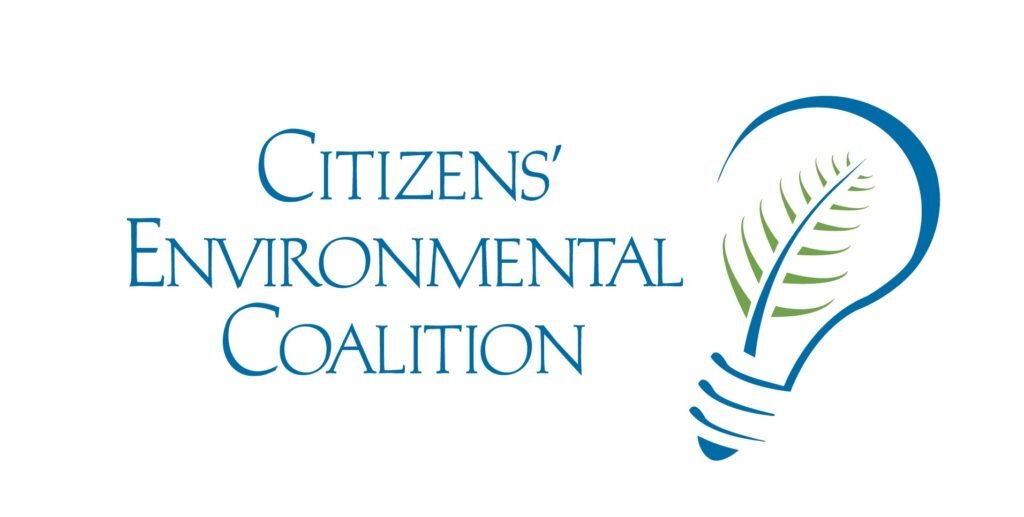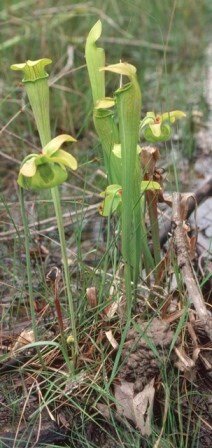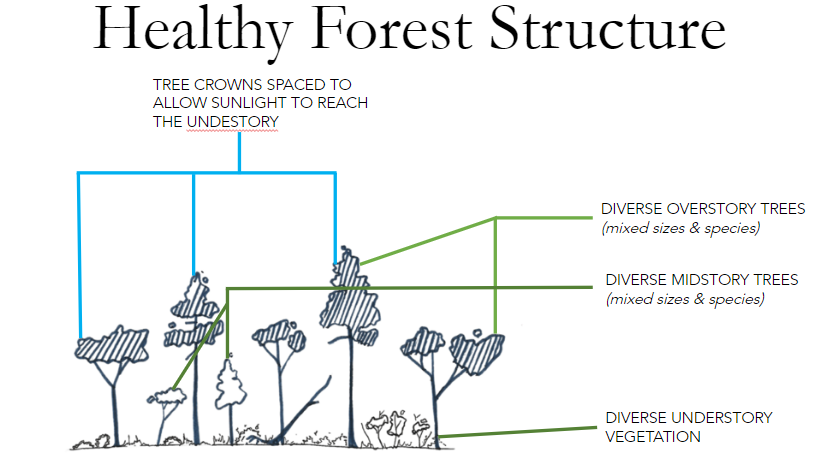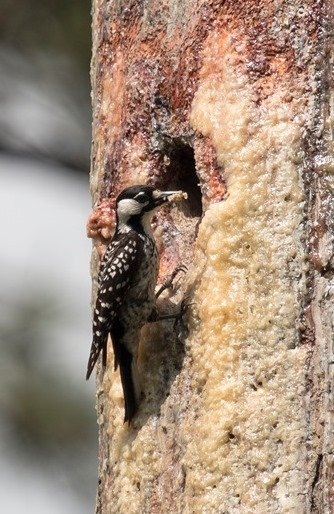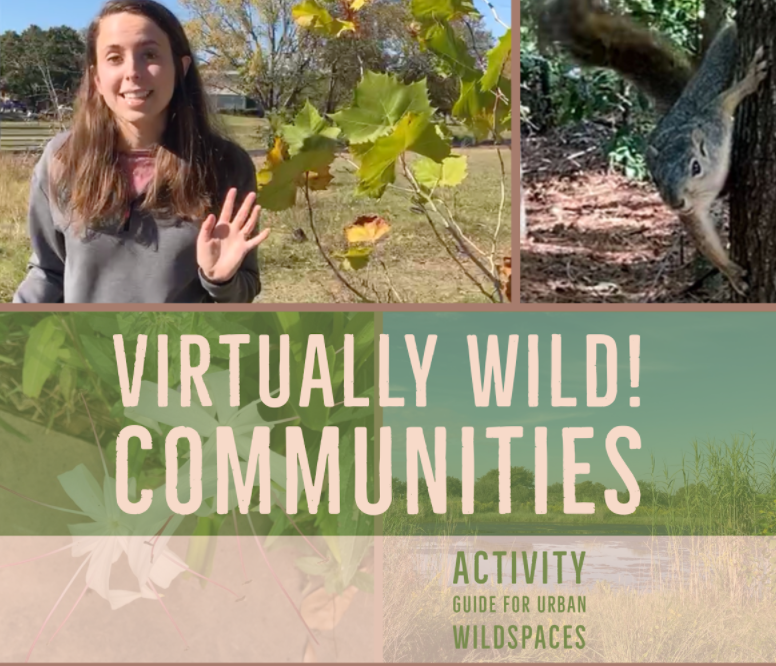Forests and the Big Thicket
Below you can find resources for teaching about the forests and Big Thicket of Texas in your learning environment.
Overview | Benefits | Conservation | Wildlife | Cultural Connections
Overview
Pitcher plant, courtesy of NPS.
According to Houston Wilderness, the Piney Woods is the southwestern-most remnant of what was once a huge contiguous pine forest that ran from East Texas through the southeast all the way to the Appalachian Mountains. They are some of the wettest areas of the state, with up to 50 inches of rainfall (on average). Soils are deep and fertile, due to a high amount of organic material. In addition to shortleaf, longleaf and loblolly pines, forests include oaks, elms, hickories, pecan, black walnut, tupelo, sweetgum and other trees. Much of the understory, or shrubbery, includes yaupon and waxmyrtle bushes.
According to the National Park Service, “the Big Thicket is the biological crossroads of North America. It has one of the most biologically diverse assemblages of species in the world. It is a transition zone where southeastern swamps, central plains, eastern deciduous forests, pine savannas, and dry sandhills meet. This diverse habitat allows an impressive array of species to coexist. In 1981, Big Thicket National Preserve was also designated as a Biosphere Reserve by UNESCO, thereby demonstrating its international importance.” It’s called the Big Thicket because plant growth is abundant, making passage often impossible.
According to Texas A&M Agrilife, the Bottomland Hardwood Forests are dominated by trees that can survive in water, because the nearby rivers often flood. They are not as wet as a swamp (which only dry out occasionally). Expect to find bald cypress trees and water tupelo trees; Trinity River National Wildlife Refuge is a great place to see a protected forest.
Our urban forests are teeming with birds and butterflies. Trees offset the urban heat island effect.
Benefits
According to the Texas Coastal Exchange, forests absorb rainwater, thus decreasing severity of heavy rainstorms and increasing groundwater capacity. As water is absorbed, forests filter nutrients like nitrogen and phosphorus, among other pollutants. Trees provide habitat for migratory birds and other wildlife, and increase shade coverage which decreases the heat island effect. Many organizations are protecting and restoring forests across the region.
Conservation
Fire is necessary in the pine forests, as long as it remains in the understory. Fire controls hardwood species and opens sealed pine cones (releasing pine seeds). It ensures sunlight hits the forest floor, encouraging wildflowers and grasses to grow. Canopy fires are dangerous, spread quickly, and destroy large trees like pines; they result from improper management of the understory and regular fire suppression.
Invasive plants like Chinese tallow trees and Japanese climbing ferns threaten the forest. They change how fire and nutrients cycle through the forest, and they can hybridize with native plants. Learn more with the Texas Invasives Database.
Bastrop State Park, and the surrounding area in Central Texas, is recovering from a massive wildfire in 2011. The park is a living laboratory for what happens following an uncontrolled wildfire, and reminds us to take care of the Piney Woods. Prescribed burns can help by reducing fuel loads and recycling nutrients back into the soil. Learn more about Wildland Fire Management.
Image: John Carey
Image: John Carey
Wildlife
The endangered Red-cockaded woodpecker is a classy bird of the pines. His red cockade, or ribbon, is on the side of his head and difficult to see. They dig insects out of trees. Bald eagles are a familiar sight, too. Blackberries and wild plums provide food for songbirds, too. Pocket gophers and Louisiana pine snakes hide in the underbrush, as do Eastern wild turkey. White-tailed deer are prevalent across Texas, including within the forest.
Louisiana black bear were historically in the area, however, no known permanent populations exist in Texas today. Beavers, squirrels, eleven species of bats, foxes, skunks, raccoons… the list of mammals goes on.
According to the National Park Service, “four of the five types of carnivorous plants found in North America can be found in Big Thicket, including pitcher plants, sundews, bladderworts, and butterworts. The most well-known carnivorous plant, the Venus flytrap, is not found here.”
Cultural Connection
Atakapas, Caddos, and the Alabama-Coushattas inhabited the area, until Anglo-Americans set up sawmills in the late 1800s. Indigenous tribes still in the area include major tribes of the Alabama and Coushatta Indians, who had migrated to Southeast Texas in the 1780s from Alabama and Louisiana. These two tribes have lived all over the Big Thicket, but they now share a common home here on their 4,300-acre reservation in Polk County.
Sawmills began dotting the landscape as settlers took advantage of the timber resources. Today, the timber industry is still the largest source of income in the region. Urban sprawl and development have severely diminished our native forests.
“Native Land Digital creates spaces where non-Indigenous people can be invited and challenged to learn more about the lands they inhabit, the history of those lands, and how to actively be part of a better future going forward together.” Visit this interactive map.
Local Resources
Resources from the Texas Forest Service and the Forest History Society.
Visit the W. Goodrich Jones State Forest near Conroe, one of the nation’s largest, working, urban Piney Woods forests. Free field trips, professional development, outreach opportunities, and more from the Texas A&M Forest Service. Call the office at 936-273-2261.
Visit the Big Thicket National Preserve in East Texas - only a :90 minute bus ride from Downtown Houston. Read more about their extensive educational programs. Schedule an educational boat trip with the Big Thicket Association & Neches River Adventures, too.
Visit the Trinity River National Wildlife Refuge - only 45 miles east of Downtown Houston - to see bottomland hardwood forests.
Project Learning Tree is an award-winning environmental education program designed for teachers and other educators. PLT uses the forest as a window into the world, engaging the next generation of America's leaders and decision makers. Find resources and professional development on the Texas PLT website.
Teacher Conservation Institute is a multi-day workshop held in East Texas which uses the forest to teach environmental education.
Tour the Texas Forestry Museum in Lufkin or participate in grade-level programs correlated to TEKS. They offer traveling trunks that are available for checkout (if you can pick up and drop off in Lufkin).
Activities/Lessons
ALL AGES
Red-cockaded woodpeckers live just north of Houston. Try this habitat lesson from Texas Parks & Wildlife Department about forests, conservation, wildfires, and protecting endangered species. PDF version of lessons for 3 - 10th grade & additional fact sheet on the woodpeckers.
Elementary School
Introduce a whole new generation of children to Smokey Bear and his message of Wildfire Prevention. Check out a variety of materials to easily integrate into your curriculum on Smokey Bear’s website.
“Succession of Forests 5E Lesson Plan PDF Version or Word Version - Science, Grade: 5th, TEK: 2,3,4, &10
"How Big is your Tree?" STEM, Grade 5
Middle School
The Trees of Texas website hosts a wealth of information, including tree biology, a tree dictionary, and a way to explore Texas Ecoregions.
The Natural Inquirer is a middle school science education journal created so that scientists can share their research with middle school students. Each article tells about scientific research conducted by scientists in the USDA Forest Service. It is available in both English and Spanish.
Create an appreciation for trees. Gather a variety of leaves in the schoolyard, and create a dichotomous key with them, using Texas A&M Forest Service Leaf ID for help with identification and terminology. (7th grade TEK 7.11A).
The Forest History Society offers "If Trees Could Talk: A Curriculum in Environmental History," an 11-module middle school curriculum, including a compilation of primary resources—documents, maps, newspaper articles, oral histories or photographs—from which students are asked to gather, examine, and analyze information, and synthesize insights. Modules cover such topics as how Native Americans and European settlers managed forested landscapes, the significance of private forests in American society, the central role of wood in America’s industrial revolution, the history of wildfire policy and what it means for us today, and the history of the environmental movement.
"How Big is your Tree?" STEM, Grade 6-8
High School
Use Texas Gateway lessons, Ecological Succession I and Ecological Succession II
Tree Trails is a project for students, by students, to celebrate trees. Enhance outdoor classrooms at schools, nature centers and public parks by creating an education trail focused on trees. Access lesson modules and the mapping program on the Tree Trails section.
The Trees of Texas website hosts a wealth of information, including tree biology, a tree dictionary, and a way to explore Texas Ecoregions.
Create an appreciation for trees. Gather a variety of leaves in the schoolyard, and create a dichotomous key with them, using Texas A&M Forest Service Leaf ID for help with identification and terminology. (Biology TEK 8).
Do a deep dive into Houston’s heat island effect with this overview from Rice University, then plant a tree from Trees for Houston. Calculate the benefit of tree canopy using this calculator.
Use i-Tree tools to easily estimate tree canopy and benefits using aerial photographs, find current and future benefits of trees in an area (like your campus), or quantify forests. Make an account with Project Learning Tree for access to free lessons using i-Tree.
Virtual Field Trips
Visit the forests of North Houston with Dr. S. He’ll show you how to use technology, like drones, to measure the health of the system.
At T.C. Jester Park, friends from Houston Parks and Recreation Department show off their native tree planting project.
Videos
Technology in the Forest
Meet Caroline Cruz, with Texas A&M Forest Service.
Legacy Tree Project
Overview of Houston’s ecosystems, with key vocabulary.
